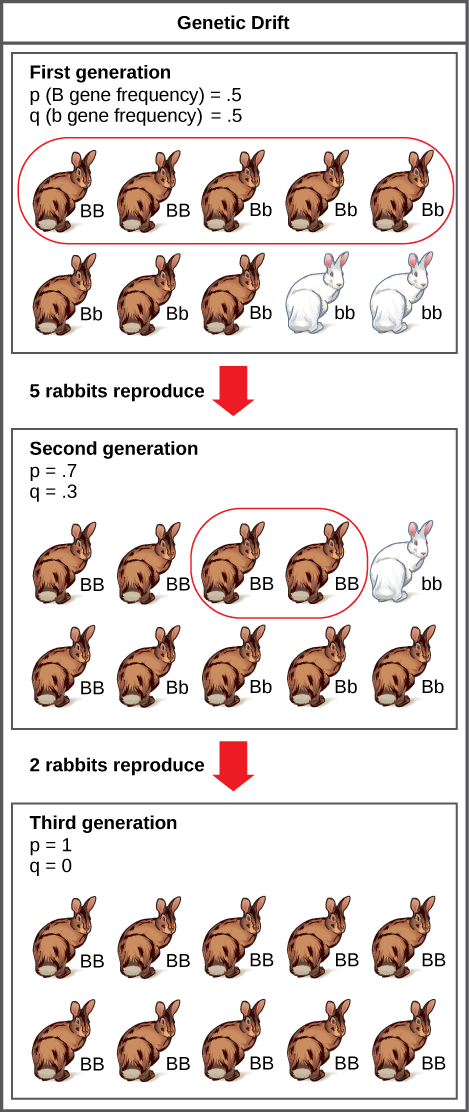Genetic drift can be defined as the loss of alleles from a population by chance. It is one of the four elements that influence the evolution of a gene pool, along with mutation, gene flow, and natural selection.

It is also referred to as the “Sewall Wright effect” based on the theory given by the author in 1969. All populations experience genetic drift. However, small populations are more frequently affected by it. Random variations in allele frequencies in small populations limit genetic diversity, increasing homozygosity and decreasing the capacity of an organism to adapt through evolution.
Example
A small rabbit population of 8 brown individuals genotype (BB or Bb) and 2 white individuals (genotype bb).
The B and b alleles frequencies are initially equal in the first generation.
If purely by chance, only the 5 rabbit population reproduced (represented in a circle). In contrast, the rest rabbits died for some reason, the frequency of the B allele will be 0.7, and the frequency of the b allele will be 0.3 in the surviving group.
The frequencies of B and b in the population changed to 0.7 and 0.3, respectively, because the five rabbits in the previous generation had different allele frequencies than the population.
From this second generation, if only two of the BB offspring survived and reproduced, by the third generation, the b allele will be completely lost from the population.

Interesting Science Videos
Effect of Population Size on Genetic Drift
- Small populations are more vulnerable to the effects of genetic drift. Contrarily, large populations are buffered against the effects of chance.
- It is significantly less likely that the b allele would be lost and that B allele would attain 100% frequency or fixation in such a short amount of time if there were a population of 1000 rabbits as opposed to just 10.
- Alleles are quickly driven to fixation in the smallest population, whereas allele frequencies are more stable in larger populations.
Types of Genetic Drift
There are two major types of genetic drift. They are:
- Population bottleneck
- The founder effect
1. Population bottleneck
- It can cause a radical change in allele frequencies in a very short time.
- A population bottleneck occurs when population size abruptly decreases due to unpredicted circumstances, such as the unexpected demise of individuals due to an environmental disaster, habitat degradation, predation, or hunting.
- A new populace is formed when a small number of individuals survive, and this new population’s gene frequency undergoes a drastic change.
- Independent of selection, some genes (including rare alleles) of the original population may see a significant increase in proportion, while others may see a significant decline or completely disappear.
- Additionally, the resulting population contains a small fraction of the genetic diversity of the original population.
Example of the Population bottleneck
Due to a population bottleneck caused by humans in the 1890s, northern elephant seals’ genetic variation decreased.
At the end of the 19th century, hunting had reduced their population to as low as 20 individuals.
Their number has now increased to around 30,000, but their genes still bear the scars of this bottleneck.
They have far less genetic diversity than a group of southern elephant seals that were not subject to as severe a hunting impact.
2. Founder effect
- When a small number of individuals leave a population to start a new subpopulation, it is known as the founder effect.
- The founder effect significantly reduces the genetic diversity in the original population.
- An allele whose frequency was extremely low in the original population may see a significant increase in frequency in the new population due to the founder effect.
Example of Founder effect
It can be observed in the prevalence of the disease in the new population because of disease-related alleles.
Old Order Amish of Eastern Pennsylvania
- The present Amish community is descended from a small group of German immigrants who came to America in the eighteenth century.
- Ellisvan Creveld Syndrome, a type of dwarfism characterized by polydactyly, anomalies of the nails and teeth, and heart issues, is much more common among the Amish population than it is among all Americans.
- A couple, Samuel King and his wife, who arrived in the region in 1744, are responsible for the disease’s origin.
- The King’s descendants inherited the mutated gene responsible for the syndrome.
- Endogamy (mating within own subgroup) is a common practice among Amish people.
- Similarly, there has also been no introduction of foreign genes into the Amish gene pool, making gene flow centrifugal (members may leave the community, but outsiders cannot join the community)
- The disease gene has consequently increased rapidly over generations.
The Afrikaner population of South Africa
- Most Afrikaner people in South Africa are descended from a single group of European immigrants who arrived there in 1652.
- These immigrants were primarily Dutch but also included Germans and French.
- Huntington’s disease is quite common in today’s Afrikaner population.
- A common progenitor in the seventeenth century was discovered to be ancestrally related to over 200 affected people in more than 50 supposedly unrelated families.
- The disease’s origin can be traced back over 14 generations to a common ancestor who carried the gene for Huntington’s disease.
References
- Bottlenecks and founder effects. Accessed from:
https://evolution.berkeley.edu/bottlenecks-and-founder-effects/ - Choudhuri S. (2014). Fundamentals of Molecular Evolution. In Bioinformatics for Beginners: Genes, Genomes, Molecular Evolution, Databases and Analytical Tools. Academic Press, pg 27-53. ISBN 9780124104716. https://doi.org/10.1016/B978-0-12-410471-6.00002-5.
- Khan Academy. Genetic Drift. Accessed from:
https://www.khanacademy.org/science/ap-biology/natural-selection/population-genetics/a/genetic-drift-founder-bottleneck - Openstax CNX. Population Genetics.
Accessed from: https://cnx.org/contents/yNlSxj0E@5/Population-Genetics - O. Honnay. (2013). Genetic Drift. In Brenner’s Encyclopedia of Genetics (Second Edition). Academic
Press, pg. 251-253. ISBN 9780080961569. https://doi.org/10.1016/B978-0-12-374984-0.00616-1. - Woodruff D.S. (2001). Populations, Species, and Conservation Genetics. In Encyclopedia of Biodiversity. Elsevier Inc., pg. 811-829. ISBN 9780122268656. https://doi.org/10.1016/B0-12-226865-2/00355-2.
